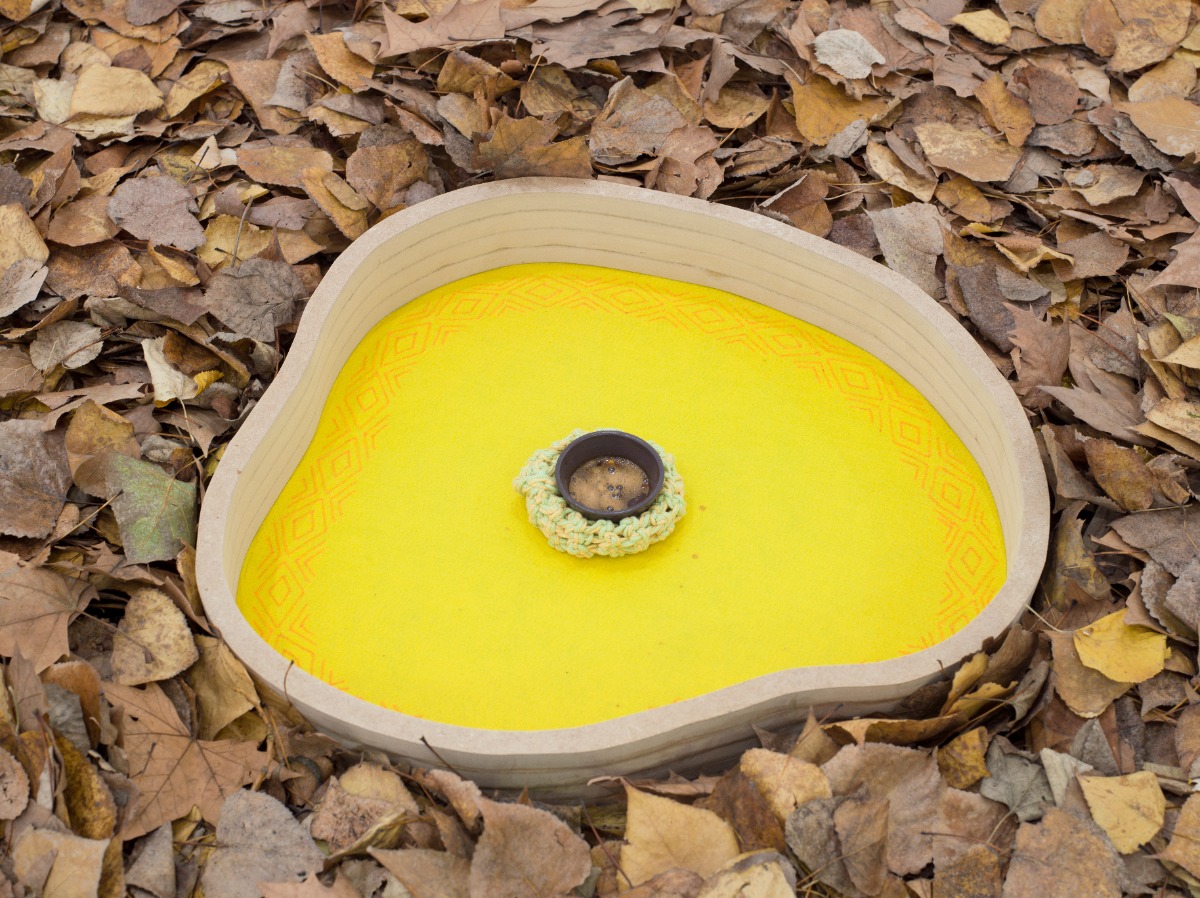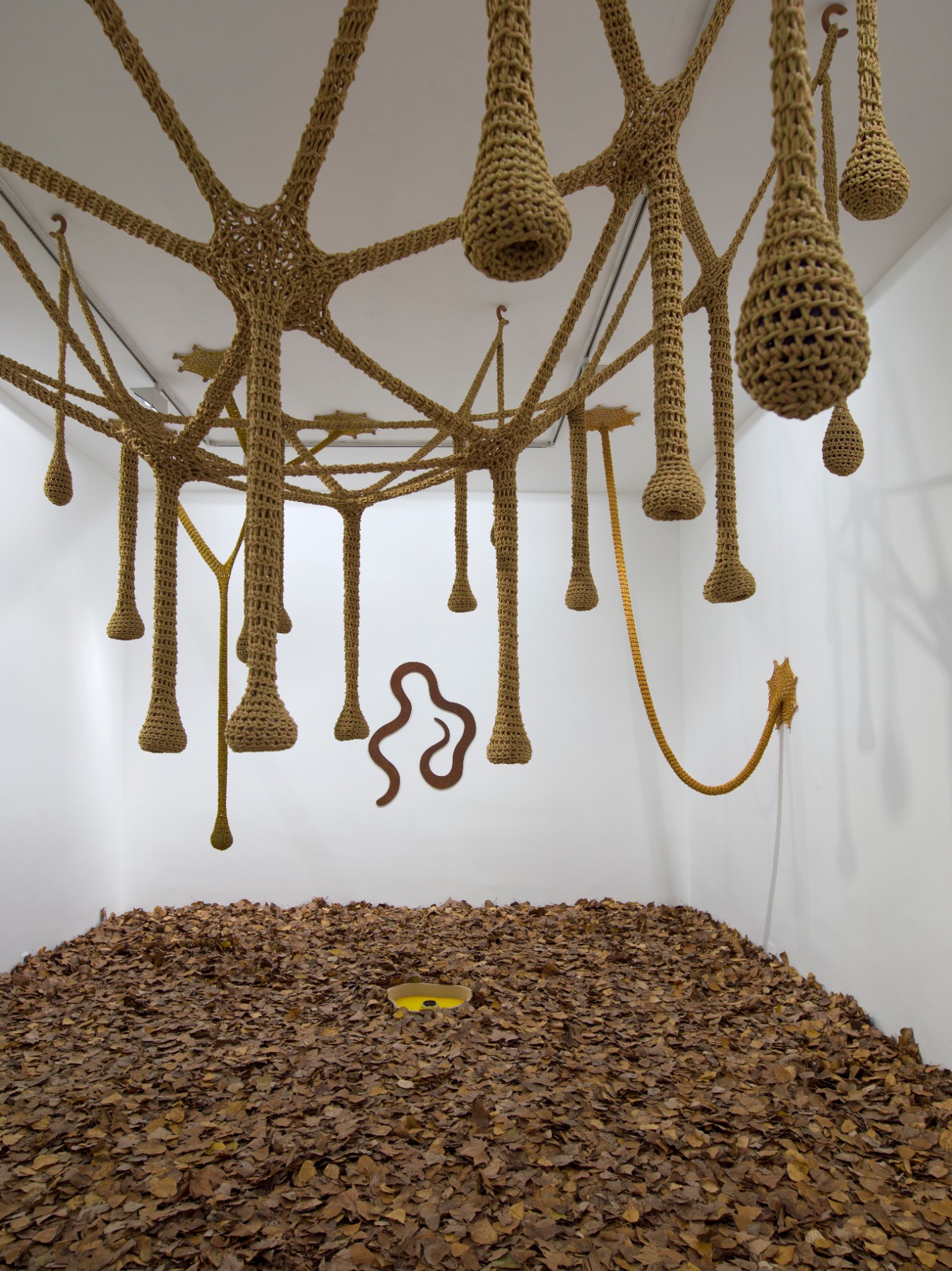
Ernesto Neto’s dedication to Spiriterritory
Jiboia
Boa Constrictor
The Jiboia is inside us,
The Jiboia is in all living things
She’s inside our cells
Two Jiboias, one male and the other female
Forming our DNA
Spiralling, dancing to infinity
From the beginning to the end of our being.
The Jiboia is our Kundalini
Our spinal column
Our connection between the earth and the sky
Between the material and the immaterial
Between the eternal and the infinite
As the Yorubá people would say,
She makes the connection between the Orun and the Aiyê
She is our vitality
Our pineal gland is the Jiboia’s head
She irradiates our strength
She guides us
She teaches us
She is in all living things
In the plants, animals and rivers
In all places, there she is, navigating the source of life, back and forth
She is also in all the ancient stories
Including the one that dominated the culture of planet Earth
That one about Genesis
There she is, giving birth to humanity
If it wasn’t for the Jiboia, the anaconda,
the cosmic, feathered serpent, and all the names she may have,
bringing the fruit of the tree of knowledge and
Giving it to Eve to share with Adam
Mother Eve, woman Eve
Today we wouldn’t be here,
Adam and Eve would be in Paradise,
but not us,
neither here, nor there!
The Jiboia brings a reinterpretation of Genesis
With a will to heal
To heal this misreading
This misleading interpretation,
The Jiboia dreams and softly slides over the earth
Over the earth’s body, with her belly she feels the body of our body
The Jiboia doesn’t speak a word, but says it all,
just breathing,
back and forth
In her wise strength, she is the tree of knowledge itself,
The Jiboia dreams
The Jiboia navigates
The Jiboia enchants
The Jiboia transforms
With music, with dance, with strength… joy and art
The Jiboia is art itself
The Jiboia, like art, also constricts
Constricts to expel, to bring out everything that needs
to be cleansed, to be healed, to be worked on
She is the oracle
She brings the questions, she brings the answers, she works us
The Jiboia is mother to all life on Earth
The Jiboia is Gaia
jiboGaia
The Jiboia is the Earth itself
jiboEarth
mama Jiboia
jiboMama
Gratitude, Axé, Haux!
The Jiboia is indigenous
We are all indigenous
Ernesto Neto
Rio, Carnival 2021 new moon
Ernesto Neto. O protesto e a serpente, 2014. Photo: Courtesy of the artist
Ernesto Neto’s dedication to Spiriterritory
When I visited Brazilian artist Ernesto Neto at his studio on February 18, 2020, to interview him for the upcoming Arterritory.com publication Arterritory Conversations: Detox and Healing for the Planet, the global pandemic was still ahead of us. Of course, we spoke about Covid-19, but back then it was still largely referred to as the “Chinese virus”. At the same time, however, it was clear that changes to the current world order, and also the need for them, would be irreversible.
Among other things, Neto said, “I think the title of your magazine, Arterritory, is absolutely great, because the art ends on territory. I once did an exhibition titled The Body as a Territory. The idea of territory is very broad, and it can happen in an abstract or material way. But there’s an important detail. In Portuguese, and I believe in any Latin language, ‘territory’ is a political body, but it is also terra, the earth, mother earth, our body. There’s a work Lygia Clark titled A Casa é o Corpo (The House Is the Body, 1968), which she called ‘biological architecture’ and ‘nostalgia of the body’. It was exhibited at MoMA in 2014. One day while dancing at a beach party under a tree, I received a message that was a variation of Clark’s statement from 1968, saying ‘A Terra é o corpo’ (Earth is the body). When we say it this way, we feel like we’re inside the earth/terra, as a part of it; we bring back the landscape to our body, and we feel as a part of it and not that it is apart from us.”
Exactly a month later, after I had returned to Riga and the pandemic had turned the usual world order upside down, I received an email from Neto, which ended with the words:
Let’s keep up the good vibe!
By the way, with all the museums, galleries and institutions down, it’s a good and important moment for magazines.
arterritory foresterritory spiriterritory
let’s go on
hugs love
e
Another month later, in April 2020 and inspired by Neto’s letter, we at Arterritory began a new section titled “Spiriterritory”. It is a space where we have conversations about vitally important issues: humans, the planet, our relationship with Earth and our future on it. We talk about what it means to be human and to be alive as well as the footprint we make in this world, all the while remaining conscious of the fact that a sustainable future for humans and the solution to the current crisis (be it ecological, social, political or mental) can only be found in interaction, in the meeting of ideas from various different fields and the subsequent synthesis of new ideas. It can only be found in a dialogue rooted in an international network – a dialogue between ancient knowledge and various spiritual practices and modern-day science, between shamans and philosophers, between artists and neuroscientists, between anthropologists and musicians, between politicians and religious leaders, between teenagers and adults, instead of only within the narcissistic “bubble” of a single discipline and a single way of thinking.
“We need a transformation of consciousness on a global scale,” declared ethnopharmacologist and thinker Dennis McKenna in an interview with Arterritory.com in late 2020. And to a certain extent these words of his became a catalyst for the transformation of Spiriterritory into a new, independent branch of Arterritory.
As Albert Einstein famously said, “We cannot solve our problems with the same thinking we used when we created them.” The process of transformation is not easy, and each one of us must find our own instruments on this path. Spiriterritory is a story about the path and instruments that lead us to ourselves and through ourselves – to the idea of a sustainable world. We believe, despite the prognoses, that this is not merely utopian thinking.
Spiriterritory is not a consciously imagined construct, but at the same time its creation is not just a coincidence. It is our small contribution to the cosmological vision of the global consciousness towards a better world, because we simply believe that such a world is possible. Likewise, it is no coincidence that the symbolic godfather of this idea is Neto, whom we first met six years ago at the opening of his exhibition in Helsinki and who at that time had only recently begun his own path of transformation.
The only truly conscious decision in the creation of Spiriterritory was my request to Neto late last year that he write a dedication to Spiriterritory. He wrote a poem and chose to illustrate it with two images from the O protesto e a serpente (The Protest and the Snake) exhibition, which took place at the Galería Elba Benítez in Madrid in 2014 and also served as a kind of turning point in his own path in life. In 2013, Neto had met the Huni Kuin tribe for the first time. It was also the first time he drank their sacred medicine ayahuasca, which he symbolically included in one of the works of art for the exhibition.
As curator George Stolz wrote in the introduction to the exhibition: “O protesto e a serpente, as its title suggests, is organised around two axes: on the one hand, protest – i.e. society’s internal reaction to its own ills – and on the other, the natural world of forests, plants and creatures (including human beings), which Neto sees as the only possible source of any and all genuine healing. Thus the exhibition includes works with explicit references (such as the phrase Quem paga o arrego, or ‘Who pays the bill?’) to the violent demonstrations that shook Brazil in 2013 and in which Neto participated first-hand, as well as works that juxtapose objects such as the cross of Christianity and the billy-clubs used by the police, both of which Neto considers ‘instruments of torture’. As Neto says, ‘the image of the cross is not an image of Christ; it is an image of those who killed him.’
“On the other hand, O protesto e a serpente also draws on the artist’s recent and ongoing experience with the Huni Kuin, an indigenous people of the rain forests of western Brazil, who are known for their profound understanding of the natural world, and whose rituals involve shamanistic healing and the use of ayahuasca as sacred medicine. For Neto, the Huni Kuin and their relationship to nature point to the possibility of healing – physical healing, spiritual healing, and healing our relationship with the earth itself – and thus a necessary alternative to the ideologies that have shaped most of what is considered to be the more ‘civilised’ world: as Neto says, ‘the earth is the body, and nature is the cure.’”
On behalf of Arterritory and Spiriterritory, we thank Ernesto Neto for his wonderful dedication, which Mariana Maia has rendered into English from Portuguese. The original, which Neto recorded as he created the poem, can be heard in the audio file below.
Una Meistere